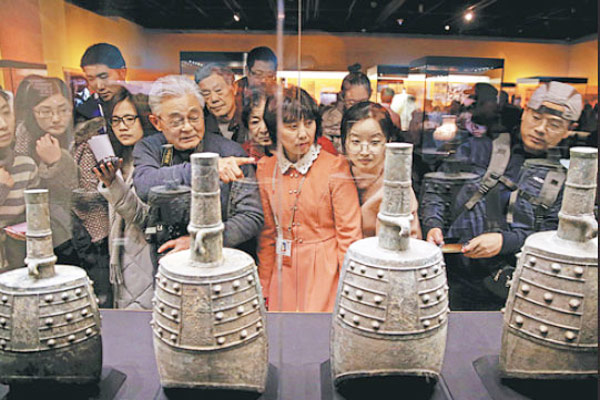 时刻新闻
时刻新闻

A set of ancient chime bells is displayed at the Capital Museum in Beijing on Wednesday. [Photo by Jiang Dong / China Daily]
China's museums, libraries and art galleries are making good on the government's pledge to promote the cultural industry and improve living standards. Wang Kaihao reports.
On March 2, an exhibition of 400 cultural relics unearthed during the excavation of the tomb of the Marquis Haihun (92 BC-59 BC) in Jiangxi province opened at the Capital Museum in Beijing.
Interest was intense because the Marquis was a well-known and controversial figure, who was also the Han emperor for just 27 days before being deposed.
Anticipating a flood of visitors, the museum, usually a free, walk-in attraction, took the unusual step of setting up an online platform and insisting that attendees book tickets in advance online. The first week was fully booked long before the doors officially opened, generating headlines in the media.
It wasn't the first time a museum had been in the news in recent years. When Beijing's Palace Museum, which is also known as the Forbidden City, staged an exhibition of 283 artistic masterpieces, including Along the River during the Qingming Festival-widely regarded as one of the finest examples of ancient Chinese painting-visitors happily waited until midnight to see the national treasures.
"Museums now have more free audio guides and attendants, and many have two-dimensional code scanning" (which allows visitors to obtain information about artifacts on their mobile devices), said Beijing resident Xia Nan, 28, who frequently visits museums in the capital.
"With new technology and better services being introduced, museums have become an important educational tool, rather than a novelty," Xia said.
For several years, the slogan "Visiting museums is a life-style" has been used to promote museums, and the rapid development of China's public cultural services system means the slogan has almost become the reality.
The promotion of Chinese culture is a crucial plank in a commitment to improve people's living standards made by the government at the 18th CPC National Congress in 2012.
Early last year, national guidance to promote the public cultural services system was published by the State Council as a way of stimulating and accelerating the development of institutions such as museums, libraries and cultural centers.
By the end of last year, China had 4,510 registered museums, 345 more than the previous year, which attracted more than 600 million visitors, according to statistics supplied by the State Administration of Cultural Heritage. Last year, 15 million people visited the Palace Museum, making it the most visited museum in the world.
"Cultural relics are not antiques to be housed in attics, or treasures that must remain secret," said Shan Jixiang, director of the Palace Museum and a member of the National Committee of the Chinese People's Political Consultative Conference. "They are cultural food, directly connected to people's livelihoods. For us, the expansion of exhibition space is a crucial step toward improving our level of service."
[NextPage]Changing concepts
In 2002, only about 30 percent of the Forbidden City was open to the public. The number now stands at 65 percent, and is set to rise further, to 76 percent, by the end of 2020, according to Shan.
Since 2014, the museum has offered half-price tickets during the slack winter season, and people in certain occupations, such as teachers, medical professionals and police officers, can obtain free passes for official group visits.
Museums are also gradually changing the concepts that underpin the exhibitions they organize. For example, at the Capital Museum's 2014 exhibition, Harmonious Life: The fate of Ba in the Eyes of a Yan Princess, 190 pieces of bronze ware were displayed to illustrate rituals that were common in North China 3,000 years ago, as seen through the eyes of a member of the contemporary nobility. The presentation was so popular that it was included in a list of the year's top 10 museum exhibitions drawn up by the State Administration of Cultural Heritage.
Guo Xiaoling, the museum's director, believes that he and his peers should always consider their visitors' needs. "There were not so many exhibits, but we paid far more attention than before to devising connections visitors would understand easily, rather than simply juxtaposing cultural relics," he said, referring to Harmonious Life.
"Now, we have to be skillful and tell stories through displays to explain why historical events happened in the way they did, and creative exhibition curators have assumed very important roles."
Song Xiangguang, a profess-or of museology at Peking University, said change was inevitable.
"Traditionally, the main function of a museum was to display artifacts to visitors, but the visitors' ideas about developing museums were ignored. Museums are not just custodians of cultural relics. Consequently, we are now more reliant on public participation, and the relationship between the exhibits and humans are now of greater concern," he said.
In March last year, the State Council's first regulation on museums took effect. The guideline urged museums to offer free entry, and to encourage the production and sale of souvenirs, such as reproductions of famous artifacts. Moreover, all museums were required to open to the public within six months of obtaining their licenses to operate. Statistics published by the Ministry of Culture show that by the end of last year, 2,780 museums were offering free entry.
In addition to improving the "hardware" (buildings and infrastructure), Song believes it's equally important for the nation's museums to improve the "software", or services and content.
"It's a good thing that museums are now considered 'windows to cities' (attracting tourists), but when more museums receive visitors free of charge, the composition of the visitors changes. That means there is more demand for visitor-oriented ideas in exhibitions and we have to listen more to their opinions, rather than just relying on policies or experts," he said.
[NextPage]A new chapter
China's public libraries have also undergone a transformation. At the end of 2014, the country was home to 3,117 public libraries, housing 790.52 million books, a rise of 5.6 percent compared with the previous year, according to data from the National Bureau of Statistics.
"Promoting the cream of traditional Chinese culture has become an important part of the government's daily work, so libraries have enjoyed a rare opportunity to develop," said Han Yongjin, director of the National Library of China.
The library is not only the world's third-largest by area, it's also a treasure trove of literary artifacts, and by the end of last year it housed more than 35 million books. In recent years, its collection has grown by 1 million books a year. The situation is a far cry from the days when the library was criticized by readers for being detached from the grassroots.
"The National Library's lending system was suspended for a long time, which was very inconvenient. For us general readers, the experience offered by a library is more important than its size," said Kang Pei, a 33-year-old writer in Beijing.
Things have now improved. In addition to resuming its lending service in 2014, the library has also opened an online data platform for readers. The digital content it shares with other public libraries is more than 140 terabytes, and covers 1.6 million books, 1,000 magazines, 230,000 papers and a range of other items. The library's website has 6.55 million registered users, and by October it had posted 4,000 online videos of public lectures, according to Han.
"In the new era, the things readers demand from a library are more diverse, so better service in terms of digital resources will become necessary in the future," he said. "When public libraries provide basic cover for every county in the country, they will become the flagships of the public cultural services system."
According to a report submitted to this year's National People's Congress by the Ministry of Culture, since 2001, the central government has allocated 4 billion yuan ($613 million) for the construction of 1,086 county-level libraries and cultural centers. And a national law for public libraries is also being drafted.
"It's good to see more new technologies being used to serve readers, and I'm very pleased to have more community-level libraries in my neighborhood," Kang, the writer, said.
"However, it's still a little disappointing to find that most readers in the community-level library near my home are seniors rather than my contemporaries. Better management will be needed if libraries want to continue increasing their influence and become more attractive to visitors," she added.
[NextPage]Wider concerns
Better utilization of resources to serve the public is not just a concern for museums and libraries, but also for the entire public cultural services sector.
The report presented by the Ministry of Culture showed that 18 provincial-level administrative regions have introduced public cultural services to the local government appraisal system. Ten administrative regions, including Zhejiang province and Xiamen in Fujian province, have been selected as trial areas for the assessment of a range of detailed standards. Meanwhile, a training program has been launched for 242,700 employees of county-level cultural services to promote better service standards.
Some observers have urged local bodies to emphasize the artistic and cultural heritage of their home regions.
"Different regions have their own individual cultural characteristics. Good content is key, so the services can't be identical everywhere. Room should be left for local authorities to nurture their own appropriate styles," said Qi Shuyu, a professor at the Chinese Academy of Governance.
That explains why the national guidance issued by the State Council last year did not include specific instructions, but instead offered general suggestions for the construction of a framework and also encouraged local governments to devise their own detailed standards based on the outline, he added.
According to Qi, financial subsidies and tax cuts are effective ways of ensuring that high-level cultural institutions, such as opera houses and art galleries, offer lower price tickets to the wider public.
To avoid wasting money, he suggested the introduction of a more scientific system to evaluate financial support for public cultural services, rather than simply setting quotas.
In response to questions from China Daily, the public cultural services department at the Ministry of Culture issued a statement that said a "branch system" of public cultural institutions will be promoted to narrow the gap in service quality across different regions and combine widespread resources.
Under the system, cultural centers and libraries at the county-level will be guided by their counterparts at a higher level, and urban institutions will be encouraged to pair with, and offer support to, their rural peers to balance development.
"The protection of different characteristics will be improved. Cultural institutions will be mobilized to preserve folklore and intangible cultural heritage, and to develop related industries to promote economic development," the statement said.



